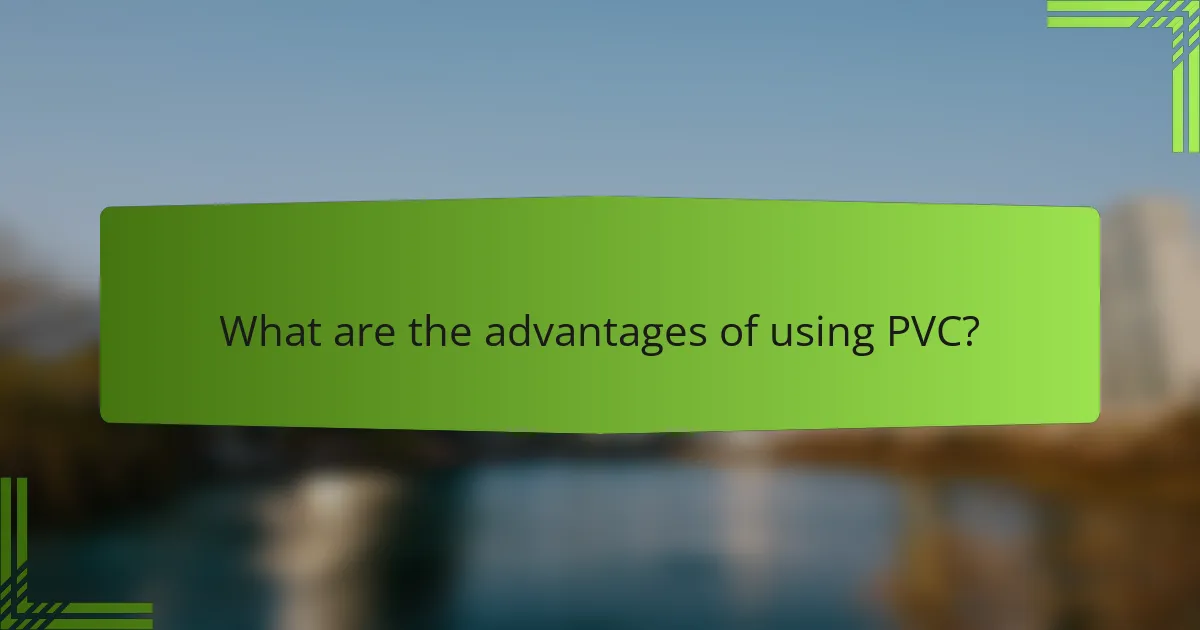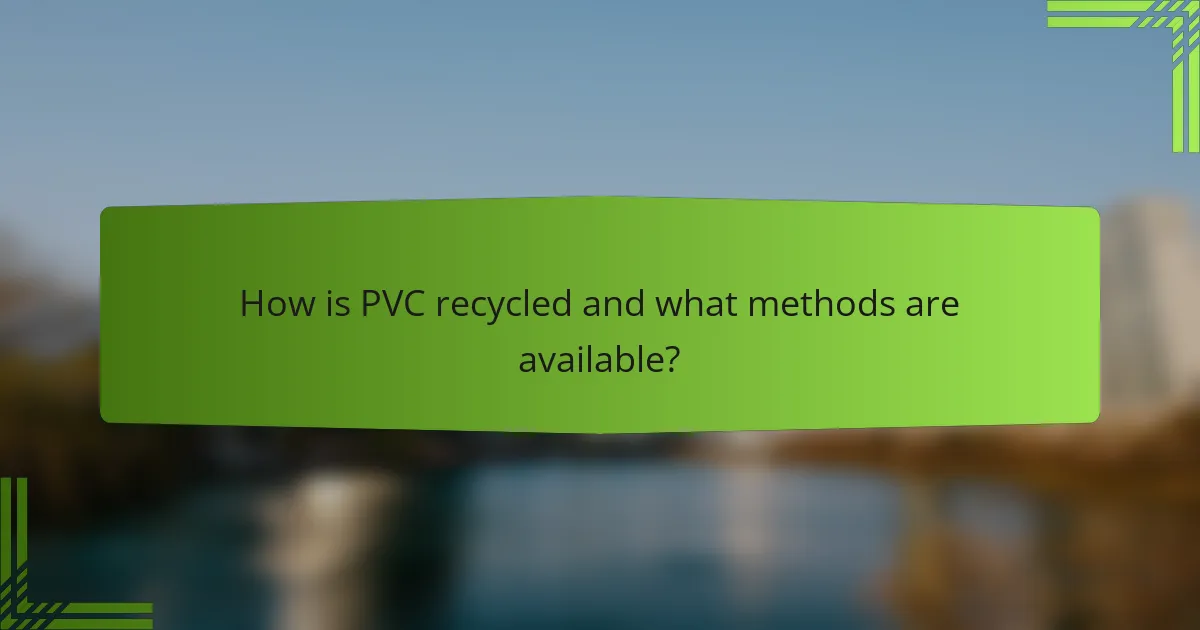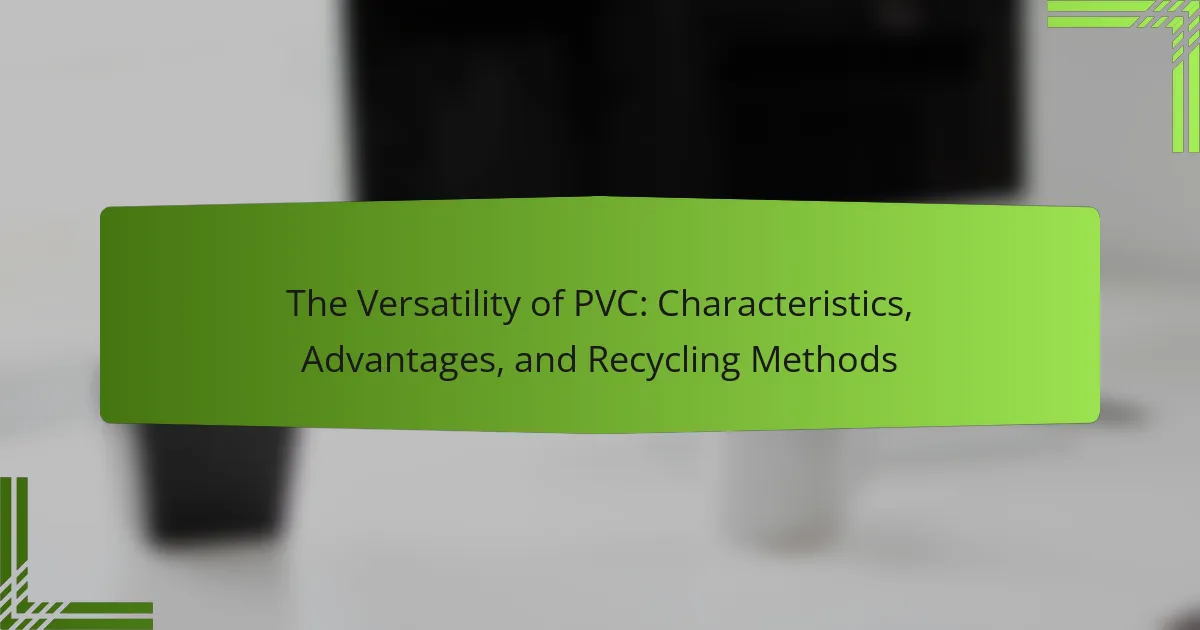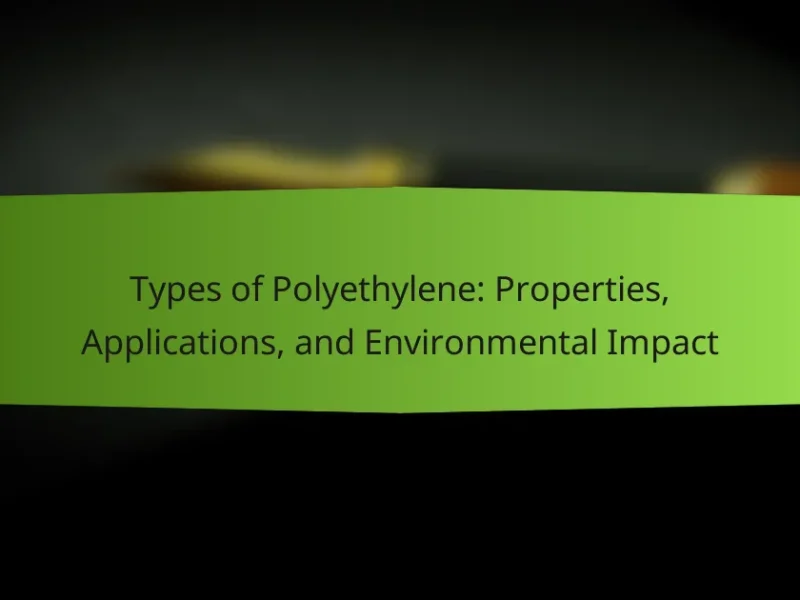PVC, or polyvinyl chloride, is a synthetic plastic polymer known for its versatility and wide range of applications. This material can be rigid or flexible, making it suitable for uses in construction, medical devices, and consumer goods. Key advantages of PVC include its durability, cost-effectiveness, and resistance to environmental factors, as well as its lightweight nature, which simplifies transportation and installation. Additionally, PVC can be easily molded and shaped, enhancing its adaptability for creative designs. The article also explores various recycling methods for PVC, including mechanical and chemical recycling, highlighting its potential for sustainable practices in multiple industries.

What is PVC and why is it considered versatile?
PVC, or polyvinyl chloride, is a synthetic plastic polymer. It is considered versatile due to its wide range of applications and properties. PVC can be rigid or flexible, making it suitable for various uses. It is commonly used in construction, medical devices, and consumer goods. Its durability and resistance to environmental factors enhance its functionality. PVC can be easily molded and shaped, allowing for creative designs. Additionally, it is cost-effective compared to other materials. The ability to recycle PVC also contributes to its versatility. These characteristics make PVC a popular choice in multiple industries.
How is PVC produced and what are its key characteristics?
PVC, or polyvinyl chloride, is produced through the polymerization of vinyl chloride monomer (VCM). This process typically involves two main methods: suspension polymerization and emulsion polymerization. In suspension polymerization, VCM is mixed with water and a suspending agent, then subjected to heat and pressure to initiate polymerization. In emulsion polymerization, VCM is dispersed in water with surfactants, leading to a different polymer structure.
Key characteristics of PVC include its durability, chemical resistance, and versatility. PVC is lightweight and can be manufactured in rigid or flexible forms. It has a high tensile strength and is resistant to environmental degradation. Additionally, PVC is non-toxic and can be recycled, which enhances its sustainability profile. Its applications range from construction materials to medical devices, showcasing its adaptability across various industries.
What are the chemical properties of PVC?
PVC, or polyvinyl chloride, is a synthetic polymer with distinct chemical properties. It is a thermoplastic material, meaning it becomes moldable upon heating. PVC is resistant to moisture, chemicals, and UV radiation. Its chemical stability allows it to maintain integrity in various environments. PVC exhibits low flammability, contributing to its safety profile. The polymer can be plasticized to enhance flexibility. It also has good electrical insulation properties. The chemical structure of PVC consists of repeating vinyl chloride units, contributing to its durability. These properties make PVC suitable for a wide range of applications, from construction to electrical insulation.
How do the physical properties of PVC contribute to its versatility?
The physical properties of PVC, or polyvinyl chloride, significantly enhance its versatility. PVC is lightweight, making it easy to handle and transport. It is also durable and resistant to environmental factors such as moisture and chemicals. This resistance allows PVC to be used in various applications, from construction to medical devices. Additionally, PVC can be manufactured in flexible or rigid forms, providing options for different uses. Its excellent insulation properties make it suitable for electrical applications. Furthermore, PVC is cost-effective, which increases its accessibility for various industries. These combined attributes establish PVC as a highly adaptable material across multiple sectors.
What are the primary applications of PVC?
PVC, or polyvinyl chloride, is widely used in construction, healthcare, and electrical applications. In construction, it serves as a material for pipes, siding, and window frames. The durability and weather resistance of PVC make it ideal for these uses. In healthcare, PVC is used to manufacture medical devices, such as blood bags and tubing. Its biocompatibility and ease of sterilization are critical for these applications. In electrical applications, PVC is utilized for insulation on wires and cables. This property helps prevent electrical hazards. Additionally, PVC is employed in packaging materials and flooring. Its versatility allows for a broad range of uses across various industries.
In which industries is PVC most commonly used?
PVC is most commonly used in the construction, healthcare, and automotive industries. In construction, PVC is utilized for pipes, siding, and flooring. The healthcare industry employs PVC in medical devices and packaging. In automotive applications, PVC is found in interior components and electrical insulation. The versatility of PVC allows it to meet diverse industry needs effectively. Its durability and cost-effectiveness contribute to its widespread adoption.
How does PVC compare to other materials in various applications?
PVC is a versatile material that compares favorably to alternatives like wood, metal, and other plastics in various applications. PVC is lightweight and resistant to moisture, making it ideal for plumbing and electrical insulation. In contrast, wood is susceptible to rot and pests, while metal can corrode. PVC’s durability allows it to withstand harsh weather conditions better than many materials. Additionally, PVC is less expensive than metals, making it a cost-effective choice for construction. Its ease of installation surpasses that of heavier materials like concrete. PVC also offers better chemical resistance than many other plastics, which is critical in industrial applications. Overall, PVC’s unique combination of properties makes it a preferred choice in numerous applications.

What are the advantages of using PVC?
PVC offers numerous advantages, including durability, cost-effectiveness, and versatility. It is resistant to corrosion, making it suitable for various applications. This material is lightweight, which simplifies transportation and installation. PVC is also low maintenance, requiring minimal upkeep over its lifespan. It can be easily fabricated into different shapes and sizes, enhancing its adaptability. Additionally, PVC is an excellent insulator, contributing to energy efficiency. Studies show that PVC can last over 50 years in certain applications, proving its longevity. Its recyclability further increases its appeal in sustainable construction.
Why is PVC favored in construction and building materials?
PVC is favored in construction and building materials due to its durability and resistance to environmental factors. It is lightweight yet strong, making it easy to handle and install. PVC does not corrode, which extends its lifespan compared to metals. Its low maintenance requirements also contribute to its popularity. PVC is cost-effective, providing a budget-friendly option for various applications. Additionally, it is versatile, suitable for pipes, windows, and flooring. The material is also recyclable, aligning with sustainable building practices. These attributes make PVC a preferred choice in the construction industry.
What cost benefits does PVC offer to manufacturers and consumers?
PVC offers significant cost benefits to manufacturers and consumers. For manufacturers, PVC is less expensive to produce than many alternatives. It requires lower energy consumption during production, which reduces overall costs. The durability of PVC leads to lower maintenance and replacement expenses. Manufacturers also benefit from its versatility, allowing for a wide range of applications without the need for multiple materials.
For consumers, PVC products often come at a lower retail price. The longevity of PVC products translates to cost savings over time. Additionally, PVC’s resistance to weathering and chemicals minimizes the need for frequent replacements. Studies show that PVC can reduce overall lifecycle costs by up to 30% compared to other materials.
How does PVC contribute to energy efficiency in applications?
PVC contributes to energy efficiency in applications primarily through its excellent insulation properties. This material minimizes heat loss in buildings, leading to reduced energy consumption for heating and cooling. PVC windows and doors can improve thermal performance by up to 30% compared to traditional materials. Additionally, PVC’s lightweight nature reduces transportation energy costs. The durability of PVC also means longer lifespans for products, which decreases the need for replacements and the associated energy expenditure. Studies show that using PVC in construction can lower energy costs significantly over time.
What are the environmental impacts of PVC?
PVC production and disposal have significant environmental impacts. The manufacturing process releases harmful chemicals, including dioxins and phthalates, into the air and water. These substances can lead to air pollution and water contamination. PVC is not biodegradable and can persist in the environment for hundreds of years. When incinerated, it emits toxic gases, contributing to air pollution. Additionally, PVC recycling rates are low, resulting in increased landfill waste. Studies show that alternatives to PVC, like bio-based plastics, can mitigate these environmental effects.
How does PVC’s durability contribute to sustainability?
PVC’s durability significantly contributes to sustainability by extending the lifespan of products made from it. Durable materials require less frequent replacement, reducing waste. This longevity minimizes the environmental impact associated with manufacturing new products. Additionally, PVC can withstand harsh conditions, which makes it suitable for various applications. Its resilience leads to lower resource consumption over time. According to the Vinyl Institute, PVC products can last over 50 years. This durability translates into fewer materials being discarded in landfills. Therefore, the sustainable use of PVC aligns with waste reduction goals.
What are the concerns associated with PVC production and disposal?
Concerns associated with PVC production include environmental pollution and health risks. The production process releases harmful chemicals like dioxins and phthalates. These substances can contaminate air, water, and soil. Disposal of PVC also poses significant challenges. Incineration can release toxic byproducts, while landfilling can lead to leaching of harmful compounds. Recycling rates for PVC are low, contributing to waste accumulation. Studies indicate that PVC can take hundreds of years to decompose. Overall, both production and disposal of PVC raise serious environmental and health concerns.

How is PVC recycled and what methods are available?
PVC is recycled through various methods, primarily mechanical recycling, chemical recycling, and energy recovery. Mechanical recycling involves grinding PVC waste into small particles, which are then cleaned and reprocessed into new PVC products. This method is commonly used due to its cost-effectiveness and simplicity.
Chemical recycling breaks down PVC into its original monomers or other useful chemicals. This process allows for the creation of new PVC without degrading its quality. Energy recovery involves incinerating PVC waste to generate energy, although this method raises environmental concerns due to emissions.
According to the European Commission, approximately 30% of PVC can be recycled mechanically. The recycling rate can vary based on local infrastructure and collection systems. In 2020, the global PVC recycling market was valued at over $1 billion, indicating a growing interest in sustainable practices.
What are the different recycling methods for PVC?
The different recycling methods for PVC include mechanical recycling, chemical recycling, and energy recovery. Mechanical recycling involves shredding PVC products and reprocessing them into new materials. This method is commonly used for rigid PVC items like pipes and window frames. Chemical recycling breaks down PVC into its basic components, allowing for the creation of new PVC or other chemicals. This method can handle contaminated or mixed materials. Energy recovery involves incinerating PVC to generate energy, which can be useful when recycling is not feasible. Each of these methods contributes to reducing PVC waste and promoting sustainability.
How does mechanical recycling work for PVC products?
Mechanical recycling for PVC products involves collecting, shredding, and reprocessing PVC waste. First, PVC products are gathered from various sources, such as construction sites and post-consumer waste. Next, the collected PVC is cleaned to remove contaminants like dirt and labels. The cleaned PVC is then shredded into small pieces. These pieces are melted and reformed into new products or pellets. The process preserves the properties of PVC, allowing for the creation of new items. Studies show that mechanical recycling can recover up to 90% of PVC’s original properties. This recycling method is efficient and reduces the need for virgin materials.
What is chemical recycling and how does it apply to PVC?
Chemical recycling is a process that breaks down plastic materials into their original monomers or other basic chemicals. This method allows for the recycling of plastics that are difficult to process through traditional mechanical recycling. PVC, or polyvinyl chloride, can be chemically recycled to recover valuable materials. The chemical recycling of PVC involves depolymerization, which converts the polymer back into its constituent monomers. This process can help reduce waste and lower the demand for virgin PVC production. According to a study from the European Commission, chemical recycling can potentially recycle up to 90% of PVC waste. This approach not only helps to manage PVC waste but also contributes to a circular economy by reintroducing materials into production cycles.
What challenges exist in the recycling of PVC?
Recycling PVC faces several challenges. One major issue is the presence of additives in PVC products. These additives can complicate the recycling process and affect the quality of the recycled material. Another challenge is the limited market demand for recycled PVC. This reduces the economic viability of recycling efforts. Contamination during the collection and sorting process further hinders recycling efficiency. Additionally, the lack of standardized recycling methods for PVC contributes to inconsistencies in recycling outcomes. Finally, the technical complexities involved in processing PVC can lead to increased costs and reduced recycling rates.
How can the recycling rate of PVC be improved?
Increasing the recycling rate of PVC can be achieved through enhanced collection programs and better sorting technologies. Effective collection systems increase the volume of PVC available for recycling. Advanced sorting technologies improve the separation of PVC from other materials. Education and awareness campaigns can encourage consumers to recycle PVC products. Establishing partnerships with manufacturers can ensure that recycled PVC is used in new products. Regulatory measures can provide incentives for recycling initiatives. According to the Vinyl Council of Australia, improved recycling processes can lead to higher recovery rates and reduce landfill waste.
What role do consumers play in the recycling of PVC products?
Consumers play a crucial role in the recycling of PVC products. Their participation begins with proper disposal practices. By placing PVC items in designated recycling bins, consumers facilitate the sorting process. Awareness of local recycling guidelines enhances this effort.
Consumers also influence the demand for recycled PVC. Increased demand encourages manufacturers to use recycled materials. This shift reduces the need for new PVC production. Furthermore, consumers can advocate for recycling programs in their communities. Their engagement can lead to improved recycling infrastructure.
Statistics show that consumer participation can significantly increase recycling rates. For example, a study from the Environmental Protection Agency indicates that communities with active consumer engagement recycle up to 50% more materials. This demonstrates the tangible impact of consumer actions on PVC recycling efforts.
What best practices should be followed for PVC recycling?
Best practices for PVC recycling include proper sorting, cleaning, and processing of PVC materials. Sorting ensures that PVC is separated from other plastics, which can contaminate the recycling stream. Cleaning removes contaminants such as dirt, labels, and adhesives, which can affect the quality of recycled PVC. Processing involves shredding the PVC into small pieces to facilitate melting and remolding.
Additionally, using designated recycling facilities that specialize in PVC is crucial. These facilities have the equipment and expertise to handle PVC safely and efficiently. According to the Vinyl Institute, recycling PVC can reduce landfill waste and conserve resources, making it an environmentally friendly choice. Following these best practices enhances the efficiency and effectiveness of PVC recycling efforts.
PVC, or polyvinyl chloride, is a synthetic plastic polymer known for its versatility and wide range of applications across various industries, including construction, healthcare, and electrical sectors. The article outlines the production methods of PVC, its key chemical and physical properties, and the advantages that make it a preferred material, such as durability, cost-effectiveness, and energy efficiency. It also addresses environmental concerns related to PVC production and disposal, highlighting the importance of recycling methods like mechanical and chemical recycling. Additionally, the article discusses the challenges in PVC recycling and the role of consumers in enhancing recycling rates, providing best practices for effective PVC waste management.


